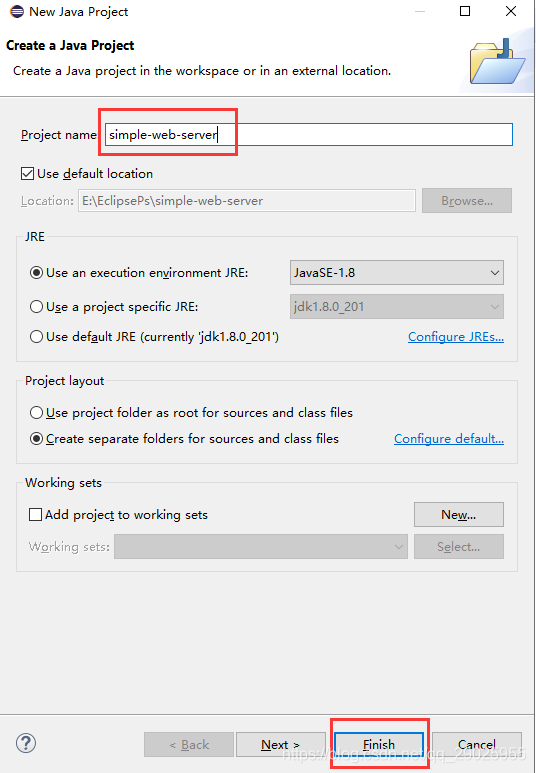新建一个普通的Java Project项目



创建三个普通类

类的作用
- HttpServer :使用 java.net.ServerSocket 监听客户端的请求,与客户端(浏览器)建立连接,获取 java.net.Socket对象以及java.io.InputStream 输入流对象和 java.io.OutputStream 输出流对象。
- Request 将客户端请求的数据封装成一个request对象。
- Response将服务器端响应的数据封装成一个Response对象。
代码
HttpServer的核心代码
- 创建一个SeverSokcet对象监听到指定端口上
int port = 8080;
try {
serverSocket = new ServerSocket(port, 1, InetAddress.getByName("127.0.0.1"));
}
catch (IOException e) {
e.printStackTrace();
System.exit(1);
}
- 使用serverSocket监听客户端(浏览器)的连接请求,监听到连接后生成Socket对象
Socket socket = null;
InputStream input = null;
OutputStream output = null;
try {
socket = serverSocket.accept();

- 根据连接的Socket对象获取输入input/输出output流对象,将输入流InputStream对象传递给Request对象,将输入流OutputStream对象传递给Response对象。
try {
socket = serverSocket.accept();
input = socket.getInputStream();
output = socket.getOutputStream();
// create Request object and parse
Request request = new Request(input);
request.parse();
// create Response object
Response response = new Response(output);
response.setRequest(request);
response.sendStaticResource();
// Close the socket
socket.close();
//check if the previous URI is a shutdown command
shutdown = request.getUri().equals(SHUTDOWN_COMMAND);
}
HttpServer的完整代码
package ex01.pyrmont;
import java.net.Socket;
import java.net.ServerSocket;
import java.net.InetAddress;
import java.io.InputStream;
import java.io.OutputStream;
import java.io.IOException;
import java.io.File;
public class HttpServer {
/** WEB_ROOT is the directory where our HTML and other files reside.
* For this package, WEB_ROOT is the "webroot" directory under the working
* directory.
* The working directory is the location in the file system
* from where the java command was invoked.
*/
public static final String WEB_ROOT =
System.getProperty("user.dir") + File.separator + "webroot";
// shutdown command
private static final String SHUTDOWN_COMMAND = "/SHUTDOWN";
// the shutdown command received
private boolean shutdown = false;
public static void main(String[] args) {
HttpServer server = new HttpServer();
server.await();
}
public void await() {
ServerSocket serverSocket = null;
int port = 8080;
try {
serverSocket = new ServerSocket(port, 1, InetAddress.getByName("127.0.0.1"));
}
catch (IOException e) {
e.printStackTrace();
System.exit(1);
}
// Loop waiting for a request
while (!shutdown) {
Socket socket = null;
InputStream input = null;
OutputStream output = null;
try {
socket = serverSocket.accept();
input = socket.getInputStream();
output = socket.getOutputStream();
// create Request object and parse
Request request = new Request(input);
request.parse();
// create Response object
Response response = new Response(output);
response.setRequest(request);
response.sendStaticResource();
// Close the socket
socket.close();
//check if the previous URI is a shutdown command
shutdown = request.getUri().equals(SHUTDOWN_COMMAND);
}
catch (Exception e) {
e.printStackTrace();
continue;
}
}
}
}
Request的核心代码:将输入流中的数据读取/解析出来
public void parse() {
// Read a set of characters from the socket
StringBuffer request = new StringBuffer(2048);
int i;
byte[] buffer = new byte[2048];
try {
i = input.read(buffer);
}
catch (IOException e) {
e.printStackTrace();
i = -1;
}
for (int j=0; j<i; j++) {
request.append((char) buffer[j]);
}
System.out.print(request.toString());
uri = parseUri(request.toString());
}
举例:在浏览器中输入:http://localhost:8080/test.html,上面的代码System.out.print(request.toString());就会打印出来如下请求信息:
GET /test.html HTTP/1.1
Host: localhost:8080
Connection: keep-alive
Cache-Control: max-age=0
sec-ch-ua: "Chromium";v="92", " Not A;Brand";v="99", "Google Chrome";v="92"
sec-ch-ua-mobile: ?0
Upgrade-Insecure-Requests: 1
User-Agent: Mozilla/5.0 (Windows NT 10.0; Win64; x64) AppleWebKit/537.36 (KHTML, like Gecko) Chrome/92.0.4515.107 Safari/537.36
Accept: text/html,application/xhtml+xml,application/xml;q=0.9,image/avif,image/webp,image/apng,*/*;q=0.8,application/signed-exchange;v=b3;q=0.9
Sec-Fetch-Site: none
Sec-Fetch-Mode: navigate
Sec-Fetch-User: ?1
Sec-Fetch-Dest: document
Accept-Encoding: gzip, deflate, br
Accept-Language: zh-CN,zh;q=0.9
以上就是request解析出来的请求信息,可以看到包括请求的地址(资源文件)/test.html 、请求头信息等。
Request的完整代码
package ex01.pyrmont;
import java.io.InputStream;
import java.io.IOException;
public class Request {
private InputStream input;
private String uri;
public Request(InputStream input) {
this.input = input;
}
public void parse() {
// Read a set of characters from the socket
StringBuffer request = new StringBuffer(2048);
int i;
byte[] buffer = new byte[2048];
try {
i = input.read(buffer);
}
catch (IOException e) {
e.printStackTrace();
i = -1;
}
for (int j=0; j<i; j++) {
request.append((char) buffer[j]);
}
System.out.print(request.toString());
uri = parseUri(request.toString());
}
private String parseUri(String requestString) {
int index1, index2;
index1 = requestString.indexOf(' ');
if (index1 != -1) {
index2 = requestString.indexOf(' ', index1 + 1);
if (index2 > index1)
return requestString.substring(index1 + 1, index2);
}
return null;
}
public String getUri() {
return uri;
}
}
Response核心代码:封装响应信息,如响应头信息(协议名称http,Content-Type:Text/html等)以及读取请求的文件/资源,如test.html文件,然后放到输出流OutputStream里面,最后在返回给请求的客户端。请求的文件/资源会提前放在服务器的指定目录下,这里是webroot目录


public void sendStaticResource() throws IOException {
byte[] bytes = new byte[BUFFER_SIZE];
FileInputStream fis = null;
try {
File file = new File(HttpServer.WEB_ROOT, request.getUri());
if (file.exists()) {
// String responseHeader = "HTTP/1.1 200 success\r\n" + "Content-Type: text/html\r\n" + "\r\n";
String responseHeader = "HTTP/1.1 200 success\r\n" + "\r\n";
output.write(responseHeader.getBytes());
fis = new FileInputStream(file);
int ch = fis.read(bytes, 0, BUFFER_SIZE);
while (ch != -1) {
output.write(bytes, 0, ch);
ch = fis.read(bytes, 0, BUFFER_SIZE);
}
} else {
// file not found
String errorMessage = "HTTP/1.1 404 File Not Found\r\n" + "Content-Type: text/html\r\n"
+ "Content-Length: 26\r\n" + "\r\n" + "<h1>File Not Found555</h1>";
output.write(errorMessage.getBytes());
}
} catch (Exception e) {
// thrown if cannot instantiate a File object
System.out.println(e.toString());
} finally {
if (fis != null)
fis.close();
}
}
Response完整代码
package ex01.pyrmont;
import java.io.OutputStream;
import java.io.IOException;
import java.io.FileInputStream;
import java.io.File;
/*
HTTP Response = Status-Line
*(( general-header | response-header | entity-header ) CRLF)
CRLF
[ message-body ]
Status-Line = HTTP-Version SP Status-Code SP Reason-Phrase CRLF
*/
public class Response {
private static final int BUFFER_SIZE = 1024;
Request request;
OutputStream output;
public Response(OutputStream output) {
this.output = output;
}
public void setRequest(Request request) {
this.request = request;
}
public void sendStaticResource() throws IOException {
byte[] bytes = new byte[BUFFER_SIZE];
FileInputStream fis = null;
try {
File file = new File(HttpServer.WEB_ROOT, request.getUri());
if (file.exists()) {
// String responseHeader = "HTTP/1.1 200 success\r\n" + "Content-Type: text/html\r\n" + "\r\n";
String responseHeader = "HTTP/1.1 200 success\r\n" + "\r\n";
output.write(responseHeader.getBytes());
fis = new FileInputStream(file);
int ch = fis.read(bytes, 0, BUFFER_SIZE);
while (ch != -1) {
output.write(bytes, 0, ch);
ch = fis.read(bytes, 0, BUFFER_SIZE);
}
} else {
// file not found
String errorMessage = "HTTP/1.1 404 File Not Found\r\n" + "Content-Type: text/html\r\n"
+ "Content-Length: 26\r\n" + "\r\n" + "<h1>File Not Found555</h1>";
output.write(errorMessage.getBytes());
}
} catch (Exception e) {
// thrown if cannot instantiate a File object
System.out.println(e.toString());
} finally {
if (fis != null)
fis.close();
}
}
}
测试
随便找一个test.html文件放到工程(服务器)指定的目录里,根据上面的代码可知,指定的目录为webroot.
注:这里的test.html文件就相当于是服务器的一个资源,远程的客户端可以请求该资源。

启动HttpServer类,运行main方法

浏览器中输入请求地址http://localhost:8080/test.html
结果
截图显示浏览器获取的了服务器端的资源文件test.html,完成了模拟一个简单的web server。
参考 : 《how tomcat works》